
A dwarf galaxy is a small galaxy composed of about 1000 up to several billion stars, as compared to the Milky Way's 200–400 billion stars. The Large Magellanic Cloud, which closely orbits the Milky Way and contains over 30 billion stars, is sometimes classified as a dwarf galaxy; others consider it a full-fledged galaxy. Dwarf galaxies' formation and activity are thought to be heavily influenced by interactions with larger galaxies. Astronomers identify numerous types of dwarf galaxies, based on their shape and composition.
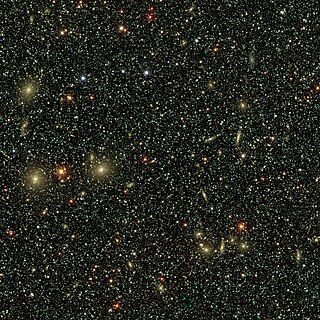
The Norma Cluster (ACO 3627 or Abell 3627) is a rich cluster of galaxies located near the center of the Great Attractor; it is about 68 Mpc (222 Mly) distant. Although it is both nearby and bright, it is difficult to observe because it is located in the Zone of Avoidance, a region near the plane of the Milky Way. Consequently, the cluster is severely obscured by interstellar dust at optical wavelengths. Its mass is estimated to be on the order of 1015 solar masses.
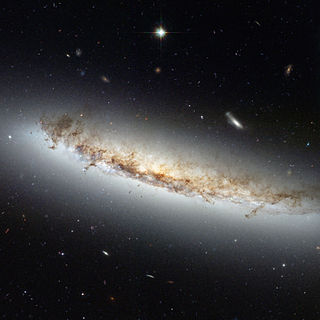
Ram pressure is a pressure exerted on a body moving through a fluid medium, caused by relative bulk motion of the fluid rather than random thermal motion. It causes a drag force to be exerted on the body. Ram pressure is given in tensor form as

The Coma Cluster is a large cluster of galaxies that contains over 1,000 identified galaxies. Along with the Leo Cluster, it is one of the two major clusters comprising the Coma Supercluster. It is located in and takes its name from the constellation Coma Berenices.
The Milky Way has several smaller galaxies gravitationally bound to it, as part of the Milky Way subgroup, which is part of the local galaxy cluster, the Local Group.
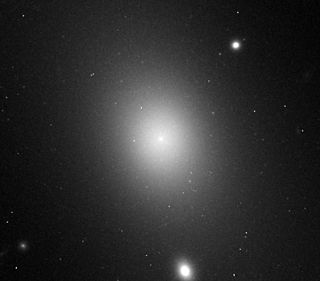
IC 1101 is a class S0 supergiant (cD) lenticular galaxy at the center of the Abell 2029 galaxy cluster. It has an isophotal diameter at about 123.65 to 169.61 kiloparsecs. It possesses a diffuse core which is the largest known core of any galaxy to date, and contains a supermassive black hole, one of the largest discovered. IC 1101 is located at 354.0 megaparsecs from Earth. It was discovered on 19 June 1790, by the British astronomer William Herschel.

ESO 137-001, also known as the Jellyfish Galaxy, is a barred spiral galaxy located in the constellation Triangulum Australe and in the cluster Abell 3627. As the galaxy moves to the center of the cluster at 1900 km/s, it is stripped by hot gas, thus creating a 260,000 light-year long tail. This is called ram pressure stripping. The intergalactic gas in Abell 3627 is at 100 million Kelvin, which causes star formation in the tails.

Hyper-Luminous X-ray source 1, commonly known as HLX-1, is an intermediate-mass black hole candidate located in the lenticular galaxy ESO 243-49 about 290 million light-years from Earth. The mass of its central black hole is estimated to be approximately 20,000 solar masses. The source was discovered at the Institut de Recherche en Astrophysique et Planétologie, Toulouse, France and gained interest from the scientific community because of strong evidence supporting it as an intermediate-mass black hole. HLX-1 is possibly the remnant of a dwarf galaxy that may have been in a galactic collision with ESO 243-49.

A2744_YD4 is a very distant young galaxy. This galaxy has first been identified as a possible distant galaxy in 2015 using the Hubble Space Telescope. This detection was made possible because this galaxy lies behind the massive galaxy cluster Abell 2744. In 2017, ALMA observed it and detected a small quantity of dust and the first signature of Oxygen emitting light only 600 million years after the Big Bang.

IC 4141 is a spiral galaxy in the constellation of Coma Berenices. The galaxy is located 900 million light-years away from Earth. Discovered in 1904 by German astronomer Max Wolf, it measures 255,000 light-years across in diameter. With a radial velocity of 19,000 kilometers per second, it is slowly drifting from the Solar System.
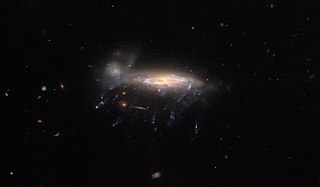
PGC 29820 is a spiral galaxy located 600 million light-years away from the Solar System in the Sextans constellation. The galaxy is about 120,000 light-years in diameter and is a member of Abell 957, a low-mass galaxy cluster. The first known reference to this galaxy is from volume I of the Catalogue of Galaxies and of Clusters of Galaxies compiled by Fritz Zwicky in 1961, where it was listed as CGCG 008-077.

PGC 65543, is a spiral galaxy, with extensive star forming regions, located in Indus. It is 650 million light-years away from the Solar System and approximately measuring 90,000 light-years in diameter. The tidal interactions from certain galaxies which PGC 65543 is moving towards to, have caused it to get distorted. Its star-forming gas and dust are dynamically stripped by ram-pressure and formed into tendrils that stretch outwards, thus gives an appearance of a jellyfish galaxy.
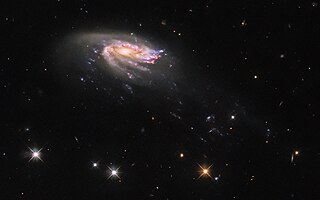
PGC 1228197 known as WINGS J211347.41+022834.9 and JO206, is a large spiral galaxy located 700 million light-years away towards the constellation of Aquarius. The galaxy is estimated to be at least 160,000 light-years in diameter, making it somehow bigger than the Milky Way. With a radial velocity of 15,226 kilometers per second, it is slowly drifting away.
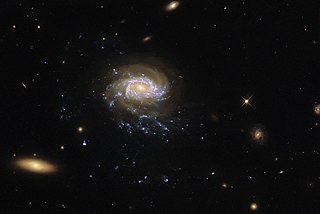
PGC 2456 known as KAZ 364 and JO201, is a spiral galaxy located in the constellation of Cetus. It is located 617 million light-years away from the Solar System. A member of Abell 85, PGC 2456 lies 360 kiloparsecs from the brightest cluster galaxy, Holmberg 15A.

IC 5337 or JW100, is a spiral galaxy located 800 million light-years away from the Solar System in the constellation of Pegasus.

4C +09.17 is a quasar located in the constellation Orion. With a redshift of 2.108300, the object is located 10.6 billion light years from Earth and presents an extragalactic astrophysical jet morphology.

4C +41.26 known as PGC 2174167, is a massive elliptical galaxy of type E located in the constellation of Canes Venatici. Its redshift is 0.228324, estimating the galaxy to be located 3 billion light years away from Earth. It is the brightest cluster galaxy of Abell 1763.

Abell 68 is massive and rich galaxy cluster located in the constellation of Pisces with a projected co-moving distance of approximately 1124.6 Mpc or 3.668 billion light-years away from Earth. The cluster is especially notable for its gravitational lensing and was first discovered by George O. Abell in 1958.




















